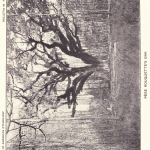The only colors utilized by the Choctaw before they obtained aniline dyes were yellow, red, and black. These, together with the natural cane, gave them four colors to combine in their work.
The old Cherokee basket now in the British Museum, known to have been obtained in Carolina in 1721, displays the same colors— yellow, red, and a very dark brown, or black. It is evident that these were the only colors used by the Southern Indians in their basket work.
The Choctaw method of making the dye and coloring the material is simple.
Yellow – To make a yellow dye they gather a quantity of roots of the Rumex crispus L. (yellow dock), which when dry are reduced to small pieces by pounding in a wooden mortar. The dye is then extracted by boiling in water. The material to be dyed is placed in the infusion and allowed to boil until the desired color is obtained.
Red – Equal parts of the bark of the Quercus texana (red oak) and the Nyssa aquatica L. (black gum) are burned to a fine ash. Water is then added to the ashes, forming a thick paste. The material previously dyed yellow, as above described, is then placed in a vessel and the ash paste poured over it. After a few hours the strong alkali turns the yellow to a deep red. The intensity of the color depends on the length of time the material remains in the ashes. If, during the first process, the material is dyed dark orange, the application of the paste causes it to turn reddish purple.
Black or dark brown – At the present time the Choctaw of Bayou Lacomb do not make a black or dark brown dye. They claim, however, that the “old people” made such a dye from the bark of a tree that grows in the north but not in this region, referring probably to the walnut.
In addition to the dyes enumerated above the Choctaw make and use a red paint, but this is seldom applied to baskets. It is made thus:

Equal parts of the bark of the Quercus texana (red oak) and the Quercus obtusiloba (post oak) and a smaller quantity of the bark of the Quercus virens (live oak) are boiled together until the liquid begins to thicken. The bark is then removed and the liquid is again boiled until still thicker. Just before removing the mixture from the fire a small piece of yellow pine pitch is added and, when melted, is thoroughly mixed with the extract. The latter is then removed from the fire and is ready for use. The drum was decorated with paint of this sort.


